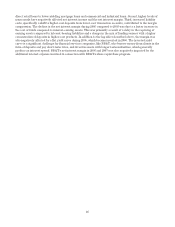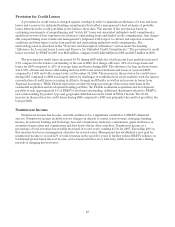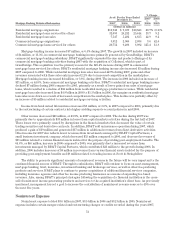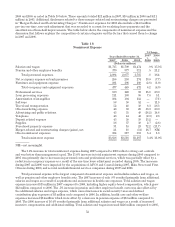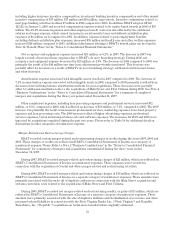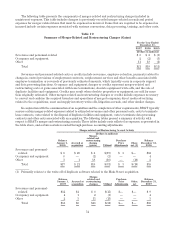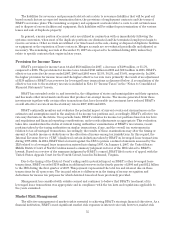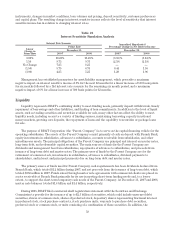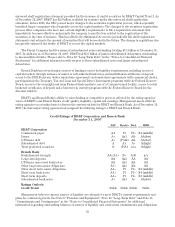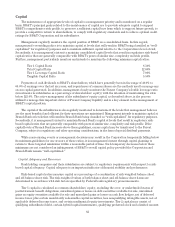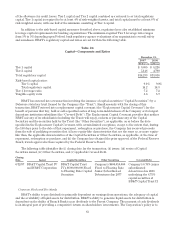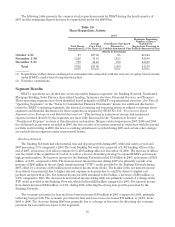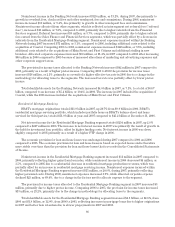BB&T 2007 Annual Report Download - page 56
Download and view the complete annual report
Please find page 56 of the 2007 BB&T annual report below. You can navigate through the pages in the report by either clicking on the pages listed below, or by using the keyword search tool below to find specific information within the annual report.also includes product liquidity risk, price risk and volatility risk. The primary objective of interest rate risk
management is to minimize any adverse effect that changes in interest rates may have on net interest income.
This is accomplished through active management of asset and liability portfolios with a focus on the strategic
pricing of asset and liability accounts and management of appropriate maturity mixes of assets and liabilities. The
goal of these activities is the development of appropriate maturity and repricing opportunities in BB&T’s
portfolios of assets and liabilities that will produce consistent net interest income during periods of changing
interest rates. BB&T’s Market Risk and Liquidity Committee monitors loan, investment and liability portfolios to
ensure comprehensive management of interest rate risk. These portfolios are analyzed for proper fixed-rate and
variable-rate mixes under various interest rate scenarios.
The asset/liability management process is designed to achieve relatively stable net interest margins and
assure liquidity by coordinating the volumes, maturities or repricing opportunities of earning assets, deposits and
borrowed funds. It is the responsibility of the Market Risk and Liquidity Committee to determine and achieve
the most appropriate volume and mix of earning assets and interest-bearing liabilities, as well as to ensure an
adequate level of liquidity and capital, within the context of corporate performance goals. The Market Risk and
Liquidity Committee also sets policy guidelines and establishes long-term strategies with respect to interest rate
risk exposure and liquidity. The Market Risk and Liquidity Committee meets regularly to review BB&T’s
interest rate risk and liquidity positions in relation to present and prospective market and business conditions,
and adopts funding and balance sheet management strategies that are intended to ensure that the potential
impact on earnings and liquidity as a result of fluctuations in interest rates is within acceptable standards.
BB&T utilizes a variety of financial instruments to manage various financial risks. These instruments,
commonly referred to as derivatives, primarily consist of interest-rate swaps, swaptions, caps, floors, collars,
financial forward and futures contracts, when-issued securities and options written and purchased. A derivative
is a financial instrument that derives its cash flows, and therefore its value, by reference to an underlying
instrument, index or referenced interest rate. BB&T uses derivatives primarily to manage risk related to
securities, business loans, Federal funds purchased, long-term debt, mortgage servicing rights, mortgage banking
operations and certificates of deposit. BB&T also uses derivatives to facilitate transactions on behalf of its clients.
BB&T’s derivatives resulted in a decrease in net interest income of $19 million and $8 million in 2007 and 2006,
respectively and produced a benefit to net interest income of $52 million during 2005. The decline in benefits to
net interest income from 2005 to 2007 can primarily be attributed to increases in rates that affected the benefits
received on BB&T’s interest rate swaps on its medium and long-term debt.
Derivative contracts are written in amounts referred to as notional amounts. Notional amounts only provide
the basis for calculating payments between counterparties and do not represent amounts to be exchanged
between parties, and are not a measure of financial risk. On December 31, 2007, BB&T had derivative financial
instruments outstanding with notional amounts totaling $47.2 billion. The estimated net fair value of open
contracts was $181 million at December 31, 2007.
See Note 19 “Derivative Financial Instruments” in the “Notes to Consolidated Financial Statements” herein
for additional disclosures.
Impact of Inflation and Changing Interest Rates
The majority of BB&T’s assets and liabilities are monetary in nature and, therefore, differ greatly from most
commercial and industrial companies that have significant investments in fixed assets or inventories.
Fluctuations in interest rates and actions of the Board of Governors of the Federal Reserve System (“FRB”) to
regulate the availability and cost of credit have a greater effect on a financial institution’s profitability than do the
effects of higher costs for goods and services. Through its balance sheet management function, which is monitored
by the Market Risk and Liquidity Committee, management believes that BB&T is positioned to respond to
changing needs for liquidity, changes in interest rates and inflationary trends.
BB&T’s interest rate sensitivity is illustrated in the following table. The table reflects rate-sensitive positions at
December 31, 2007, and is not necessarily indicative of positions on other dates. The carrying amounts of interest rate
sensitive assets and liabilities are presented in the periods in which they next reprice to market rates or mature and
are aggregated to show the interest rate sensitivity gap. To reflect anticipated prepayments, certain asset and liability
categories are shown in the table using estimated cash flows rather than contractual cash flows.
56


